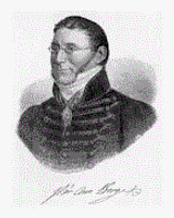Pär Aron Borg
Pär Aron Borg (4 July 1776 in Avesta – 22 April 1839) was a Swedish pedagogue and a pioneer in the education for the blind and deaf.
Borg was a teacher. After having seen a play where a deaf boy communicated by gestures, he was inspired to create a manual alphabet. He began to educate deaf and blind students regularly in 1808.
He founded Allmänna institutet för Blinda och Döfstumma (The Public Institute of the Blind and Deaf) in Stockholm in 1809 with protection from the Queen, Hedwig Elizabeth Charlotte. His perhaps most famous student was Charlotta Seuerling. The school had deaf teachers, and the education was given by sign language. He made a trip to Portugal in 1823–28, where he founded a school for the deaf; thereby, Portugal was given the same manual alphabet as Sweden.
He was the guardian and mentor of Johanna Berglind, also she an important figure in the history of the education of the deaf in Sweden.
References
|
|---|
|
|
|
| By region[a] | | Sign languages by region |
|---|
| Oceania | |
|---|
| Asia |
- Bengali
- Chinese
- Philippine
- Indonesia: Indonesian, Kata Kolok (Benkala, Balinese)
- India: Alipur, Bengali Indo-Pakistani, Naga
- Israel: Al-Sayyid Bedouin, Ghardaia, Israeli, Kafr Qasem, Yiddish
- Japan: Amami Oshima, Japanese
- Korean
- Malaysia: Malaysian, Penang, Selangor
- Mongolian
- Nepal: Ghandruk, Jhankot, Jumla, Nepalese
- Persian
- Saudi Arabia: Saudi
- Singapore
- Sri Lankan
- Taiwanese
- Thailand: Ban Khor, Thai
- Vietnamese
|
|---|
| Africa | |
|---|
| Europe | |
|---|
| North America |
- Plains Sign Talk
- Canada: American, Blackfoot, Cree, Ojibwa, Maritime, Quebec, Inuit, Plateau
- Mexico: Chatino, Mayan, Mexican
- United States: American (Black American), Blackfeet, Cree, Cheyenne, Ojibwa, Keresan, Martha's Vineyard, Navajo, Navajo Family, Plateau, Sandy River Valley, Henniker
|
|---|
| South America | |
|---|
| International | |
|---|
|
|---|
|
Language
families[a] | | Sign languages by family |
|---|
| | |
|---|
| |
|
|---|
| | |
|---|
| |
|
|---|
| Chinese Sign |
|
|---|
| | | | |
|
|---|
| Austro-
Hungarian |
|
|---|
| Old Belgian | |
|---|
| | |
|---|
| Dutch | |
|---|
| Italian | |
|---|
| Mexican | |
|---|
|
|---|
| | |
|---|
| | |
|---|
| |
- Bangalore-Madras Sign Language
- Beluchistan Sign Language
- Bombay Sign Language
- Calcutta Sign Language
- Delhi Sign Language
- Nepali
- North West Frontier Province Sign Language
- Punjab-Sindh Sign Language
|
|---|
| | |
|---|
| | |
|---|
| | |
|---|
| | |
|---|
| | |
|---|
| |
- Haiphong
- Hanoi
- Ho Chi Minh City
|
|---|
| | |
|---|
| | |
|---|
| Kentish |
|
|---|
| Other |
|
|---|
| Isolates | |
|---|
|
|---|
|
| ASL | |
|---|
|
Extinct
languages | |
|---|
|
| Linguistics | |
|---|
|
| Fingerspelling | |
|---|
|
| Writing | |
|---|
|
Language
contact |
|
|---|
|
| Media |
- Films (list)
- Television programmes (list)
|
|---|
|
| Persons | |
|---|
|
| Organisations | |
|---|
|
| Miscellaneous | |
|---|
|
^a Sign-language names reflect the region of origin. Natural sign languages are not related to the spoken language used in the same region. For example, French Sign Language originated in France, but is not related to French.
^b Denotes the number (if known) of languages within the family. No further information is given on these languages. |
